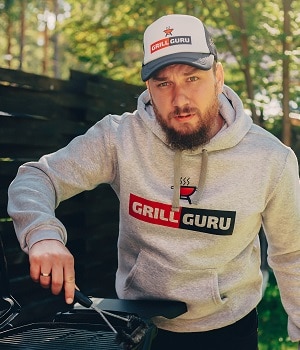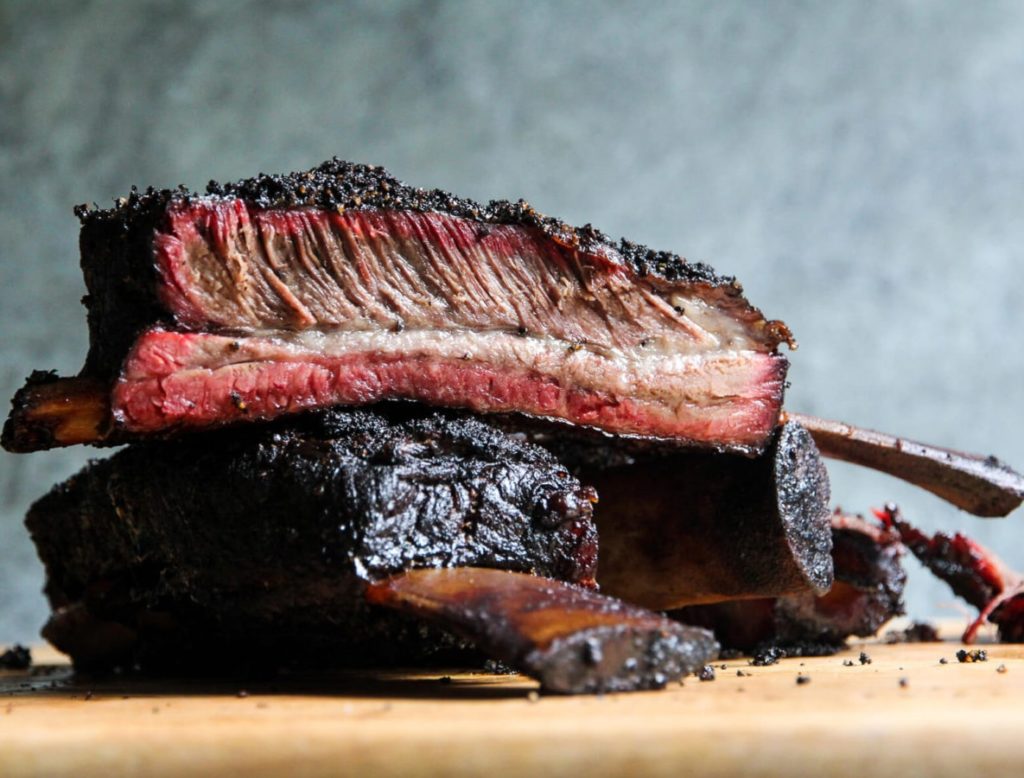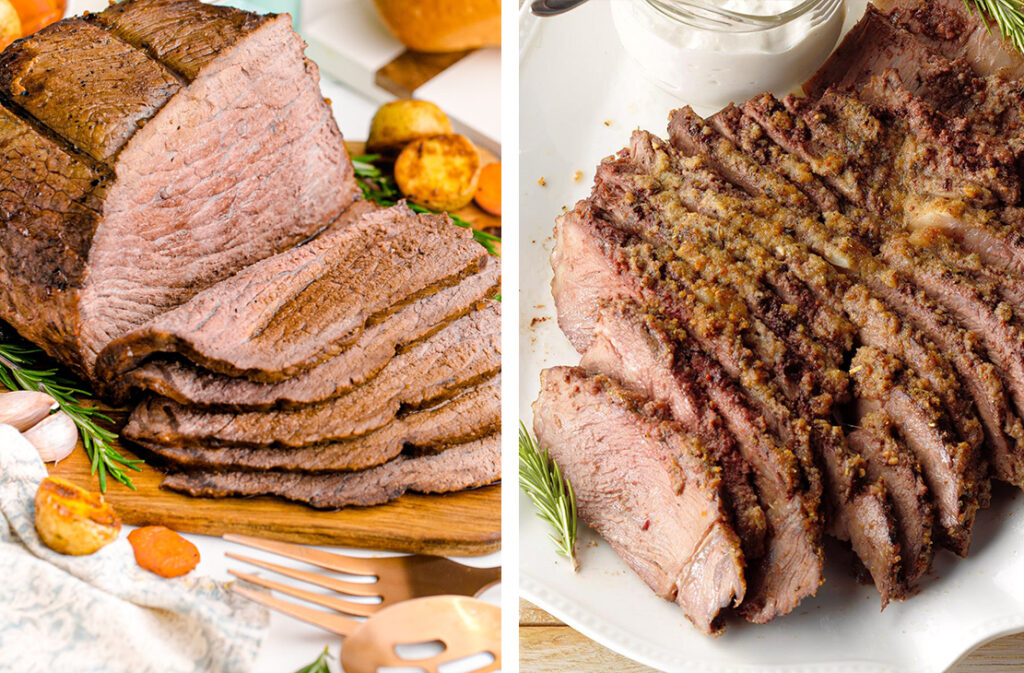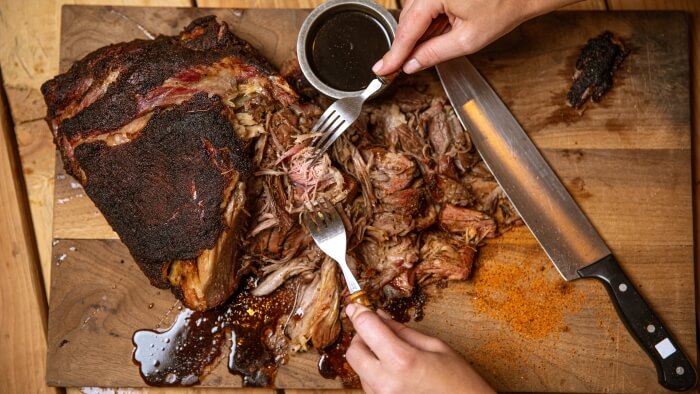

The brisket comes from the animal’s chest. This part contains no bones, is surrounded by fat, but inside it almost exclusively contains very little marbled meat. Its cooking is slow, but it is worth all the trouble. A whole brisket contains two muscles, that is, the flat and the point. In this brisket flat vs point comparison, we’ll define what both cuts are, compare them side by side, and tell you how to best cook each.
We will also teach you how to trim and break down a whole brisket; that is, how to separate a flat from the point to make them ready for the prepared rub and then the pit.
Also known as the first cut, the flat cut is that part of the whole brisket where there is lean muscle. When you remove the deckle, this part lays flat, hence, the reason it’s called a flat cut. The flat can include a thick layer of fat which is called the cap. This renders out while cooking, giving the meat more flavor, but not as much as the point. A flat cut is often long and has a rectangular appearance. It is larger than the brisket point cut.
The brisket point cut is that part where, when you have separated the whole packer, you have most of the fat. This cut is thick, small, has connective tissue. The result of the high-fat layer is more flavor when smoked. However, the point doesn’t have as much meat as the flat has. When this brisket part is cooked, there would not be a lot of meat left.
First, you should know the essence and reasons you may want to separate a flat from a point.
There can be different reasons why you want to separate a brisket point from a brisket flat.
One reason may be that you’re in a competition. In a competition, you may want to get that perfect smoke ring around your flat. So you’re going to need to separate the point away from the flat side. The smoke ring is even and consistent.
It may be that you want to turn the point into burnt ends and you want the most perfect and square burned ends. So you can trim the point first.
Also, you may need to cut the flat from the point to be able to cook it a lot quicker. Logically, thinner meats cook a lot faster than thicker ones.
The other reason you want to separate the point from the flat is if you wanted to do something like pastrami. So, in the case of pastrami, most people have been using something like the brisket flat. So you can separate the brisket flat. You can then take it through the pickling process and then through the smoking process to make the most delicious pastrami.
To follow this tutorial, you need a whole brisket also known as a packer brisket. 10 to 12 pounds of meat will be enough. This whole brisket contains two muscles, that is, the flat and the point.
For those who like to leave quite a bit of fat on the brisket, all you need to do is make the fat uniform and get off all the hard fat. In this sense, you may leave about a quarter-inch of fat all around.
First, you have to flip the meat over and start trimming up at the bottom. You will come back and finish the top. Once you separate the point from the flat, you need to start where there’s a big chunk of fat and get rid of most of that. But again, leave a little layer of it once all the hard thick fat on the top and bottom of the brisket are evened out.
To separate the flat from the point, you should know that you don’t have to do this before cooking. You can cook it whole, but many prefer to do it before they cook it. That way, you wouldn’t need to fumble around with a hot piece of meat.
So, the steps are as follows:
So, what’s the best part for smoking, the point or the flat? The point and the flat are both delicious parts. So, telling which is better for smoking can be difficult. However, it depends on what you’re looking to get and your taste.
What’s known as the point is the part of the brisket that is fattier. However, the fat will render out and become tender and flavorful. The flat also tastes good, but it tends to be very dry. It’s not always as much flavorful as the point is.
If you wish to slice your beef brisket, choose the flat part. Its lean and rectangular shape makes it easier for making uniform slices. The flat has a flavorful taste but it’s not always fatty.
If you are planning to make barbecued sandwiches with beef and would like to shred your brisket, you can choose the point. This is more tender. However, the fat content won’t let you have a lot of meat.
There are many ways to smoke a brisket. But the point requires extra care as you have a lot of fat here, especially if you’ve decided not to strip the fat. Texas brisket is best cooked with a fat layer of around 6mm and you can get this with the point. Therefore, we’ll be showing you how to cook a brisket point the Texas-style.
Follow our advice to smoke a brisket point. But first, you’ll need to prepare a spicy salt mixture to rub on all surfaces of the piece of meat as well as a vinegar and beer sauce.
One 2.5 kg (5.5 lb) beef brisket
5ml (1 teaspoon) ground cumin
5ml (1 teaspoon) dried oregano
5ml (1 teaspoon) cayenne pepper
45ml (3 tablespoons) Chili seasoning
15ml (1 tablespoon) Coarse salt
10ml (2 teaspoons) Black pepper
10ml (2 teaspoons) Brown sugar
10ml (2 teaspoons) Garlic salt
5ml (1 teaspoon) Onion powder
250ml (1 cup) distilled white vinegar
250ml (1 cup) beer
15ml (1 tablespoon) Garlic salt
15ml (1 tablespoon) Brown sugar
1 teaspoon (5ml) flaked hot peppers
5ml (1 teaspoon) Black pepper
1.5 L (6 cups) of wood chips (oak or hickory) soaked for 1 hour in cold water or beer and drained
Here also, we’ll see how to smoke brisket flat the Texas style. The difference between the process of the two is basically in the temperature. The temperature can be varied. You may start with 225 degrees Fahrenheit and add about 30 degrees more in 30 minutes and another 30 degrees in another 30 minutes. As the meat is leaner and thicker, you can choose to inject the brisket.
A 10 to 12-pound beef brisket
1/4 cup of chili spices
1/4 cup of salt
1/4 cup of pepper
1 cup of paprika
1 cup of onion salt
1 cup of garlic salt
1/4 cup of brown sugar
1 cup of cayenne pepper
1/2 cup of beef broth
1/2 cup of dark beer
1 cup of rub
The brisket flat and point are the main muscle part of the brisket in an animal, which lies in the animal’s chest, specifically, the first five ribs. While the flat seems to be thicker and beefier, the point has a lot of fat and due to this, it is usually very flavorful. While a flat cut will give you a better-burned end, a point cut will give you the best flavor. However, the flat cut is leaner, even in structure, and therefore easier and less intimidating to smoke.
In this brisket flat vs point comparison article, we’ve also shown you how to separate a flat from the point in a whole packer brisket. So, the next time you have a whole pack of brisket, don’t be afraid to trim it up and separate it.





